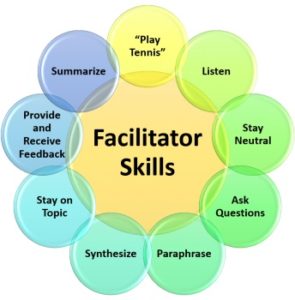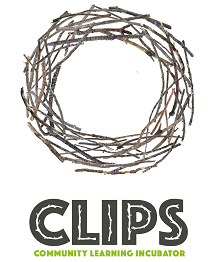Purpose and background
 Facilitation is the basic skill required to qualify as a CLIPS trainer and – naturally – facilitator, and the most recommended background for anyone who wishes to offer consulting and supervision to group processes of any kind. It can be defined as “the art and practice to make meetings easier (from the latin root “facilis”), more effective, fun and productive for all the parties involved” (ex. IIFAC website). Facilitation is not a fixed set of techniques and tools used in meetings, but rather a wider and deeper attitude rooted in the ethical values of social justice, inclusiveness, and fairness. To this end, a basic training on process work is recommended to acquire deeper knowledge on crucial topics like rank, role and leadesrhip (see separate articles).
Facilitation is the basic skill required to qualify as a CLIPS trainer and – naturally – facilitator, and the most recommended background for anyone who wishes to offer consulting and supervision to group processes of any kind. It can be defined as “the art and practice to make meetings easier (from the latin root “facilis”), more effective, fun and productive for all the parties involved” (ex. IIFAC website). Facilitation is not a fixed set of techniques and tools used in meetings, but rather a wider and deeper attitude rooted in the ethical values of social justice, inclusiveness, and fairness. To this end, a basic training on process work is recommended to acquire deeper knowledge on crucial topics like rank, role and leadesrhip (see separate articles).
Although the “Art of Facilitation” applies to different environments (from communities and non-profit NGOs to business world, political parties and public administrations) there are common features that are present in all settings.
Communities and small groups cannot always afford professional, external facilitation, that is highly recommended for meetings of particular importance and relevance. The CLIPS approach strongly encourages even small and spontaneous groups to facilitate every meeting and rely on internal resources, members who have a personal interest and inclination in the field and are willing receive a proper training. Attending facilitated meetings of other groups can inspire people to adopt this extremely effective method and to bring it in their own context. The presence of a facilitator is highly recommended, but when this is not possible, at least some basic tools must be in place (agenda, minute taking, a speaking order, action plan, follow up).
Brief Example of the Process:
In order to facilitate a meeting, a series of steps are necessary: a) a well balanced agenda (including time and place for the meeting) should be prepared in advance and timely shared with all participants and other relevant stakeholders, inviting for their feedback and contribution; b) the physical setting should be prepared to welcome the event, and all necessary materials and tools should be available, tested and ready for use to avoid loss of time and confusion; c) the meeting itself, in its various phases (introduction, agenda presentation, presentation – debate – decision on each topic; creation of the plan of activities with deadlines and task assignment; closing and thanking the group); d) making sure that minutes are taken and are available to all participants; e) follow up on decisions and consequent activities; f) planning the next meeting.
Although all phases are important, phase c) is the core of a facilitator’s job. Supporting the group through the various – and often repeated – phases (presentation, information, debate, definition, decision, and others), helping them to “give birth” to the best possible result (with unwavering trust in the process) all through the (sometimes exhausting) “labor pains” is a service of the highest value, and a clear manifestation of the Art of Facilitation.
During the meeting, a variety of techniques can be applied to keep the group active, internally cohesive and on track with the agenda, and we invite you to refer to the methods and tools present on this website. Balancing the group dynamics, and respecting both the agenda and the group energy, can magically transform meetings from frustrating and boring moments into interesting and rewarding socio-political events, that people actually look forward to with sincere anticipation.
Phase e) should also be carefully considered, a solid plan for follow-up activities must be produced (and openly shared!) to ensure that all commitments are respected and actions carried out as decided; deadlines and assigned tasks should be noted in the minutes, as well as moments for evaluation and feedback on the planned activities.
Outcomes / Benefits, Influence on the 4 layers of CLIPS:
In the CLIPS approach, meeting facilitation is first of all part of the structure layer. It directly relates to organizing the group’s activities and daily life, that is necessary made by a series of large and small decisions that lead to actions and results. Meetings are the fundamental moments for group governance, the time when decisions are officially made and the group’s highest political power is expressed: the impact of these decisions will shape the future both for individuals and the community. Solid and well balanced decisions will lead to effectiveness and satisfaction, increasing the chances of the group to reach its mission while keeping aligned with its vision.
Facilitation also cuts across all the CLIPS layers:
- it integrates all individuals, who feel seen and heard, and thus increase their sense of belonging to the group and their loyalty to the decisions that have been made);
- it strengthens community by helping members feel more aligned and focused, and thus carry out the necessary actions that fulfill the strategic plan, vision and mission of the group;
- it reminds the participants of the shared intentions by defining in detail what actions will be carried out to make the group’s intention visible in the world;
- it contributes to a better practice, reinforces to the group’s orientation and satisfies the real needs and wishes of the group members.
What is needed to put it in practice?
First of all, this approach needs a group that is willing to speak about intimate issues and to deal respectfully with it. There needs to be a basic trust in the other group members and shared values about diversity, self-responsibility and respect. Participants need an attitude of empathetic benevolent curiosity about the human being in general, and about every participant in the concrete group situation. They should be able to open, share and question themselves. As said above, attending a well facilitated meeting can be a real mind opener and create enthusiasm for this orderly and yet creative way to organize the work. Becoming a good facilitator, and making it a profession, requires personal talents and a good level of experience. One can start reading a manual (many are available in many languages) and assisting friend facilitators when this opportunity is possible. Wider facilitation skills can be learned in specific trainings that can last from a couple days (an introduction weekend) to several years for detailed, in-depth courses. A certificate or diploma is issued by each institute/school according to its own protocol.First of all, this approach needs a group that is willing to speak about intimate issues and to deal respectfully with it. There needs to be a basic trust in the other group members and shared values about diversity, self-responsibility and respect. Participants need an attitude of empathetic benevolent curiosity about the human being in general, and about every participant in the concrete group situation. They should be able to open, share and question themselves.
Further Information - Possibilities to get training in the approach.
The IAF (International Association of Facilitators) and the IIFAC (International Institute for Facilitation and Change, that has originated the European IIFAC-E) are good references for the international standards. Literature on the subject is widely available.

